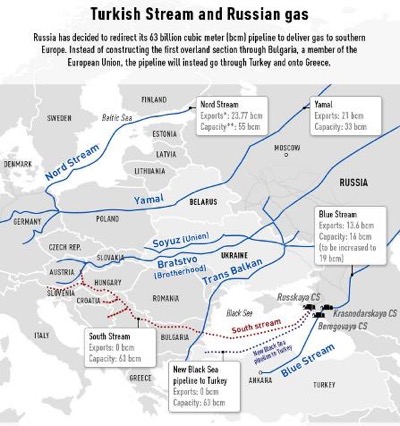The resumption of gas negotiations between Moscow and Ankara: Thierry Meyssan proposes interpreting this as the Turkish response to Vladimir Putin denouncing Ankara’s support to Daesh during the G20 whereas Manlio Dinucci sees it as a serious decision challenging Washington. He therefore proposes interpreting Turkey’s destruction of the Russian Sukhoi warplane as the US sabotaging Turkish-Russian relations. In contrast, Thierry Meyssan sees this operation as Ankara trying to drive Russia out of the area where it is trying to create a pseudo-Kurdistan. Both hypotheses must be taken into account.

The missile Aim-120 Amraam launched by the Turkish F-16 (both of which were made in the USA) was not directed only at the Russian fighter bomber launched in Syria against Isis, but for a much more important objective: Turkish Stream, the gas pipeline project that would carry Russian gas into Turkey and from here to Greece and other EU member states.
Turkish Stream is Moscow’s response to Washington torpedoing the South Stream gas pipeline that, by-passing Ukraine, would have carried Russian gas to Tarviso (Udino) and from here into the EU, bringing at the same time huge advantages for Italy in terms of job creation. [1] The project, launched by the Russian Gazprom and the Italian Eni and then enlarged to include the German Wintershall and the French Edf, was already at an advanced phase of construction (Eni’s Saipem already had a contract for 2 million euro to construct the gas pipeline through the Black Sea) when after triggering the Ukraine crisis, Washington launched what the New York Times defined as “an aggressive strategy aimed at reducing the supply of Russian gas to Europe”.
In December 2014, under US pressure, Bulgaria blocked the works of South Stream, burying the project [2]. However at the same time, even though Moscow and Ankara were on opposing sides regarding Syria and Isis, Gazprom signed a preliminary agreement with a Turkish company Botas to build a double Russia-Turkey gas pipeline running through the Black Sea.
On 19 June, Moscow and Athens signed a preliminary agreement on extending Turkish Stream (costing 2 billion dollars and paid for by Russia) up to Greece, making it (Greece) the gateway for the new gas pipeline’s entry to the European Union [3].
On 22 July Obama telephone Erdogan and asked Turkey to withdraw from the project [4].
However, on 16 November Moscow and Ankara announced a new governmental meeting to launch Turkish Stream, which had a greater capacity than the bigger pipeline going through Ukraine. Eight days later, the demolition of the Russian fighter plan triggered the interruption, if not cancellation, of the project.
Washington must have toasted the new success. In contrast, Turkey which imports 55% of its gas and 30% of its oil from Russia, is damaged by the Russian sanctions and risks losing big business of Turkish Stream. Now who in Turkey is interested in intentionally bringing down the Russian fighter plan, knowing what would be the consequences? Erdogan’s remark: “We wish that this did not happen but it happened. I hope that that this sort of thing will not happen again.” He implies a more complex scenario than the official one. In Turkey there are important US-led Nato commands, bases and radars. It was in this context that the order to bring down the Russian fighter plane was given.
At this point, what is the situation in the “war on gas pipelines”? The US and Nato control the Ukrainian territory through which the EU/Russian gas pipelines passes, but Russia is less confident in this (the quantity of Russian gas to be exported to Europe that they transport has dropped from 90% to 40%) thanks to the two alternative corridors.
– North Stream that, at the North of Ukraine, carries Russian gas to Germany: Gazprom now wants to redouble it but there is opposition to the project in the EU by Poland and other governments in the East (which have greater ties with Washington that Brussels).
– Blue Stream which Gazprom and Eni share management of, which passes at the South through Turkey and is for this reason at risk.
The EU could import much gas at a low price from Iran, through a gas pipeline already planned for, through Iraq and Syria. However, this project has been blocked (not fortuitously) by the war triggered in these countries by the US/Nato strategy.
[1] “How Vladimir Putin Upset NATO’s Strategy”, by Thierry Meyssan, Translation Roger Lagassé, Voltaire Network, 13 December 2014.
[2] “Chi ha sabotato il gasdotto South Stream”, di Manlio Dinucci, Tommaso di Francesco, Il Manifesto (Italia) , Rete Voltaire, 10 giugno 2014.
[3] “Greece to invest $2 bn in Turkish Stream, will sign memorandum asap - Energy Minister”, Russia Today, June 1, 2015.
[4] This information does not appear in the White House publication: “Obama’s Call with Turkish President Erdoğan”, The White House, July 22, 2015.

 Articles by this author
Articles by this author Send a message
Send a message





















Stay In Touch
Follow us on social networks
Subscribe to weekly newsletter